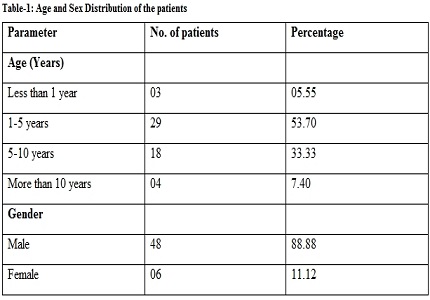Clinical study and management of congenital inguinal hernia in a tertiary care teaching institute
Abstract
Background: Inguinal hernia in children is a quite common presentation and inguinal herniotomy is a frequently done procedure in children for inguinal hernia. Inguinal hernia has a higher familiar incidence and it has been observed with increasing frequency in twins and siblings of patient. The aim of the study is to evaluate the clinical presentation, management and outcomes of the patient with congenital inguinal hernia undergoing herniotomy.
Methods: This prospective study includes 54 patients who were operated for congenital inguinal hernia at Bundelkhand Medical College and Associated Hospital Sagar from April 2015 to October 2016. Patients of age group 2 months to 12 years were included in the study. Patients presenting with acute scrotal conditions like incarcerated hernia, strangulated hernia and obstructed hernia were excluded from the study. A detailed history, clinical presentation and routine investigations, were done in all cases.
Results: In the present study most of the patients were male. Inguinal hernia can occur at any age but majority of the patients 53.70 % are seen between 1-5 years of age. Swelling in the inguinal region was the commonest symptoms. Incidence is slightly higher on the right side. Almost all of the inguinal hernias in paediatric age group are of indirect type, which develops due to congenitally patent processes vaginalis. The most common post-operative complication was reactive hydrocele and all of them resolved by the second week. No recurrence was reported in the study.
Conclusions: Inguinal hernia is a common surgical condition in children. Early surgical intervention in form of inguinal herniotomy is the most appropriate management of inguinal hernia in children
Downloads
References
2. Bronsther B, Abrams MW, Elbiom C. Inguinal hernias in children: a study of 1000 cases and a review of the literature. J Am Med women’s Assoc 1972 Oct;27(10): p522-525.
3. Grosfeld et al, Inguinal hernia in children – The factors which affected the recurrence in 62 cases. Journal of Paediatric surgery.1991 March; Volume 26 Issue 3: p265-87.
4. Peevy KJ, Speed FA and Hoff CJ. Epidemiology of inguinal hernia in preterm neonates. Paediatrics 1986 Feb;77(2): p246-247. [PubMed]
5. Czeizel A, Gardonyi J et al. A family study of congenital inguinal hernias. American Journal of Medical Genetics 1979; Volume 4 Issue 3: p247-254.
6. Jones ME, Swerdlow AJ, Griffith M, Goldacre MJ. Risk ofcongenitalinguinal hernia in siblings: a record linkage study. Paediatr Perinat Epidemiol.1998 Jul;12(3):288-96. [PubMed]
7. Glick LP, Boulanger SC et al. Inguinal hernias and hydrocele. Paediatric Surgery Sixth Edition Volume 2 Mosby 2006: p1172-1192.
8. Kapur P Caty MG, Glick PL. Paediatric hernias and hydrocele. Paediatric Clin North AM 1998 Aug; 45(4): p773-85. [PubMed]
9. Nazem M, Heydari Dastgerdy MM, Sirousfard M. Outcomes of Paediatric Inguinal hernia repair with or without opening the external oblique muscle fascia J Res Med Sci 2015 Dec; 20(12): p1172-1176.
10. Saranga Bharathi R, Arora M, Baskaran V. Paediatric inguinal hernia: Laproscopic vs Open surgeries. JSLS, 2008 July- Sep; Volume 12(3): p277-281
11. Yip KF, Tam PK and Li MK. Laparoscopic flap hernioplasty: An innovative technique for Paediatric hernia surgery. Surgical Endoscopy 2004 July; Volume 18 Issue 7: p1126-1129.
12. Saka R, Okuyama H. Sasaki T et al. safely and efficiency of laparoscopic percutaneous Extra peritoneal Closure for inguinal hernia and hydrocele in children. A comparision with traditional open repair. Journal of Laproendoscopic Advanced Surgical technique Part A 2014 Jan; Volume 24 Issue 1: p55-58.
13. Suvera MS, Damor PB Patel SB. Surgery for Inguinal hernia in Paediatric age. Int J Res Med Sci 2013 May;Volume 1Issue 2: p112-115.
14. V Ravikumar, Rajshankar S, Haresh R. S. Kumar, Nagendra Gowda MR: A clinical study of management of inguinal hernias in children on the general surgical practice. Journal of Clinical and Diagnostic Research 2013 January; Volume 7 Issue 1: p144-147.
15. Dinesh L Jadhav, Manjunath L, Vikas G Krishnamurty: A study of inguinal hernia in children. Int J of Science and Research, Dec 2014, Volume 3 (12): p2149-2155.
16. Okunribido O, Ladipo JK and Ajao OG. Inguinal hernia in paediatric age group, Ibardan experience, East Afr. Med. J, 1992;Volume 69 Issue 6: p347-348.
17. Grosfeld JL. The current concepts in inguinal hernias in infants and children. World Journal of Surgery 1989 Sep- Oct; Volume 13 Issue 5: p506-15.
18. Dan Poenaru, Inguinal hernias and hydrocele in infancy and child hood: A consensus statement of the Canadian Association of Paediatric Surgeons: Paediatric Child Health, 2000 Nov-Dec;Volume 5 Issue8: p461-462.
19. Rowe MI, Copelson LW, Clatworthy HW. The patent processus vaginalis and the inguinal hernia. J Pediatr Surg. 1969 Feb;4(1):102-7.
20. Grosfeld et al. Inguinal hernia in children, the factors which affected the recurrence in 62 cases. Journal of Paediatric Surgery1991 March: Volume 26 Issue 3: p265-83.
21. Scorer CG, Farrigton GH. Congenital deformities of testes and epididymis. London Butterworth’s:1971; Chapter 3: p15-102. [PubMed]
22. Rescorla FJ, Grosfeld JL. Inguinal hernia repair in the perinatal period and early infancy: clinical considerations. J Pediatr Surg. 1984 Dec;19(6):832-7. [PubMed]
23. Holder TM, Ashcraft KW. Groin hernias and hydroceles. Paediatric Surgery Edition 1: Philadelphia WB Saunders Company 1980; p594-608.
24. Gahukamble DB, Khamage AS. Prospective Ramdomized controlled study of excision vs distal splitting of hernia sac and processus vaginalis in the repair of inguinal hernias and communicating hydrocele. J Paediatric Surg. 1995 April; Volume 30 Issue 4: p624-5.



 OAI - Open Archives Initiative
OAI - Open Archives Initiative


















 Therapoid
Therapoid

